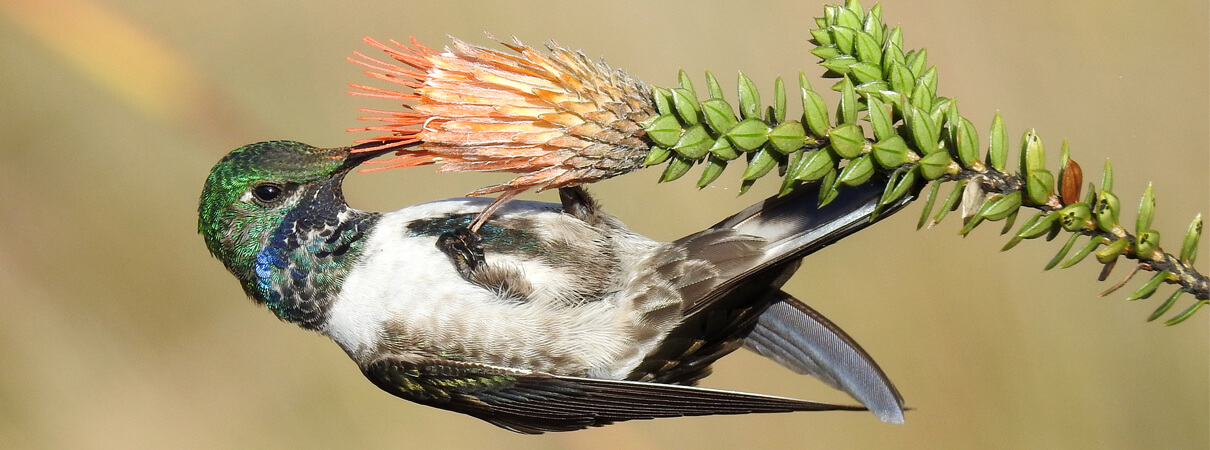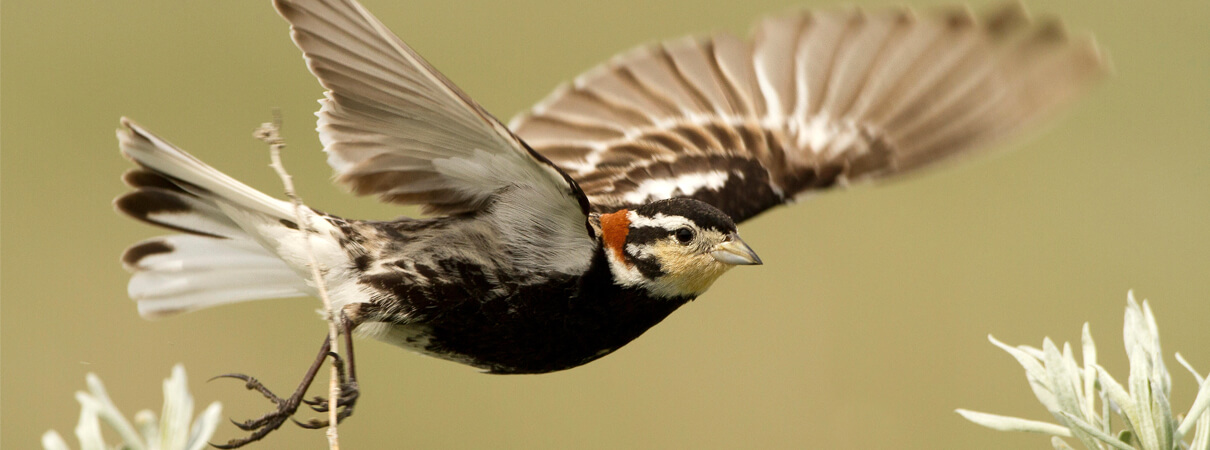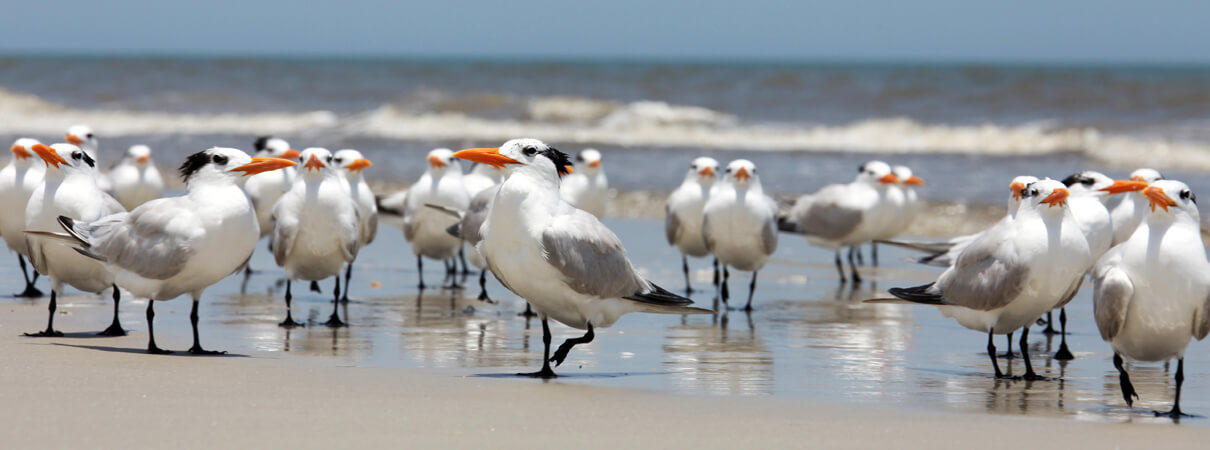Top 2020 Bird Conservation Highlights
In spite of the challenges posed by the global pandemic, American Bird Conservancy (ABC) and partners rallied our way to a great year in 2020, achieving notable gains for bird conservation throughout the Western Hemisphere. We created new protected areas for some of the most endangered bird species; supported the advancement of bird-saving legislation in Congress; celebrated the return of rare seabirds to protected habitat in Hawai'i; and much more. Here are a few highlights from this remarkable year.
1. For the rarest species, ABC helped protect more than 9,000 acres of habitat and planted almost 300,000 trees and shrubs.
In Ecuador, ABC partner Fundación Jocotoco purchased the first lands (110 acres) to establish the Cerro de Arcos Reserve to protect habitat for the recently named Blue-throated Hillstar. Supported by ABC and Rainforest Trust, this effort protects alpine meadows, locally known as páramo, critical to the survival of the extremely rare hummingbird.
We also supported Fundación Jocotoco in its purchase of 46 long-term lease agreements to protect the largest-known population of the Lilacine Amazon parrot and expand the Las Balsas Reserve from 32 to 246 acres.
ABC and other supporters worked with Fundación Biodiversa Colombia to expand their El Silencio Reserve by 3,839 acres, providing more habitat for the Critically Endangered Blue-billed Curassow, along with wintering Prothonotary Warblers and many other birds.
In Peru, we worked with ECOAN to establish a 3,185-acre community-owned protected area called Kuntur Wachana to conserve Polylepis woodlands and endemic birds such as the Critically Endangered Royal Cinclodes. This new protected area expands the Vilcanota Reserve Network to more than 21,000 acres.
Our Western Program celebrated the establishment of a 1,683-acre conservation easement on the S & R Allen Ranch with our partner Colorado Open Lands — work that benefits the Gunnison Sage-Grouse.
Finally, with our partners, we were able to plant almost 300,000 trees and shrubs to help restore habitat for some of the Western Hemisphere's most endangered birds. This total included nearly 700 trees and 80 acres in the name of new ABC members or their loved ones.
2. A court overturned federal efforts to weaken the Migratory Bird Treaty Act (MBTA).
ABC, along with several partners, won our lawsuit in federal court to overturn the Administration's 2017 reinterpretation of the MBTA. This court decision reaffirmed the Act's power to provide consequences to industries whose actions result in the preventable killing of birds. ABC continues to fight last-minute efforts by the Administration to undermine the Act.
3. To reverse migratory bird declines, we worked across millions of acres from Canada to Mexico.
2020 saw progress in efforts to reverse drastic declines of grassland birds, the bird group identified as the “biggest loser” in the 2019 “3 Billion Birds” study. Bird conservationists including ABC have created a Central Grasslands Roadmap that targets conservation actions at millions of acres of prairie from Canada to Mexico and unites partners in an ambitious goal: to cut declines of grassland bird population in half within ten years.
In a step toward that milestone, eight public-private conservation partnerships known as Migratory Bird Joint Ventures (JVs), some led by ABC staff, joined forces with 63 federal, state, provincial, nonprofit, and industry partners to complete the North American Great Plains Grassland Assessment in 2020. The effort will guide the identification of undisturbed grasslands and priority conservation sites for the Long-billed Curlew, Sprague's Pipit, Chestnut-collared Longspur, and other grassland species.
Also this year, the ABC-led Rio Grande JV improved 7,276 acres of grasslands by treating creosote and other invasive brush adjacent to high-quality grasslands that support wintering grassland birds. We also partnered with landowners to enhance over 6,500 acres of grassland in South Dakota through rotational grazing, which ensures a more diverse grassland as cattle are moved from pasture to pasture.
Our restoration work continued in other habitats as well: For example, the Lower Mississippi Valley JV completed enhancements on 11,250 acres of open pine and bottomland hardwood habitats. The work will benefit species including the Chuck-will's-widow and Bachman's Sparrow.
And, following an absence of more than 100 years, the Brown-headed Nuthatch was reintroduced to Missouri. Forty-six birds from Arkansas were translocated to restored pine woodlands in Missouri's Mark Twain National Forest — a site where the ABC-led Central Hardwoods JV and partners worked for many years to create suitable habitat to make the reintroduction possible.
4. Seabirds' return demonstrated conservation progress in Hawai'i.
An historic effort to save the Endangered Hawaiian Petrel, or ʻUaʻu, reached a critical milestone after years of waiting by ABC and project partners: The first of 87 chicks translocated from unprotected burrows to the haven of Nihoku (Kīlauea Point National Wildlife Refuge) returned after maturing at sea for several years. (A trail camera captured the moment; see video below.)
Five of the young translocated birds had returned at last count, and two pairs had formed, representing a significant step forward in our efforts to create a new seabird colony protected from cats, rats, and other invasive mammalian predators. These birds were translocated to this site as chicks in 2016 and 2017. A high-tech predator-proof fence surrounds the area, helping to ensure favorable conditions for breeding seabirds.
In another seabird success story, Wedge-tailed Shearwaters were documented breeding at the Mokio Preserve on the north shore of Moloka'i, Hawai'i. ABC and the Molokai Land Trust will install a predator-proof fence around Mokio that will ultimately protect 90 acres to support colonies of “Wedgies” and other seabird species, hopefully including the Laysan Albatross. Meanwhile, a temporary fence to keep out deer has enabled native plants to take root. The August 2020 discovery of nesting Wedgies is evidence that conservation efforts at the site are working.
5. Legislation to reduce bird collisions passed the U.S. House of Representatives.
H.R. 919 – the Bird-Safe Buildings Act, a bipartisan bill designed to reduce bird mortality by calling for federal buildings to incorporate bird-safe building materials and design features, was agreed by the U.S. House of Representatives in 2020. ABC has advocated for this legislation for more than 10 years, working with Reps. Mike Quigley and Morgan Griffith, along with other supporters. We are optimistic that the legislation may soon pass the Senate and become law.
6. New habitat created by Virginia hosted a thriving waterbird colony.
Urged and advised by ABC and partners, the Commonwealth of Virginia came through on its commitment to provide new nesting areas for a colony of terns and gulls rendered homeless by construction at the Hampton Roads Bridge-Tunnel's South Island. The newly prepared habitat was ready to receive the birds returning from migration in spring 2020, and it appears that a colony of mostly Royal Terns — the largest in Virginia — nested successfully. The project ultimately won a 2020 Governor's Honor Award for “Innovative Spirit.”
7. Measures advanced to limit cats on the landscape.
Reducing the number of free-roaming feral cats is especially critical in places like Hawai'i, where more native birds have been lost to extinction than in any other place on Earth. This year, following outreach and testimony by ABC and our partners, the County of Kauai passed a budget that included $50,000 to remove feral cats from county property.
On the mainland, the Virginia House of Delegates postponed further consideration of a bill opposed by ABC that sanctioned cat abandonment via Trap, Neuter, Release (TNR).
8. Action Fund created to mobilize and recognize federal leadership.
In 2020, we launched the American Bird Conservancy Action Fund, ABC's 501(c)(4) affiliate. The primary aims of our Action Fund are to educate members of Congress about proposals to help conserve birds and habitats — and to highlight the leadership and activities of our congressional bird conservation champions. Through our 501(c)(4), we will highlight the importance of migratory birds and recognize members of Congress who take a leadership role to conserve them.
Underlying all of our conservation results is ABC's top-notch team, which grew this year thanks to the support of our generous donors. We were thrilled to launch the California Central Coast Joint Venture (C3JV), which will guide conservation efforts in one of the country's most biologically important regions. In addition, we were proud to welcome ABC's first Chief Diversity Officer, who is expanding ABC efforts to ensure that people of all backgrounds have the opportunity to learn about and conserve birds.
We extend our deepest appreciation to ABC members and supporters, who made all of these bird conservation results possible. Thank you!
 | Clare Nielsen is ABC's VP of Communications. |






















































